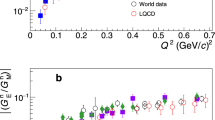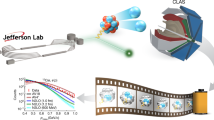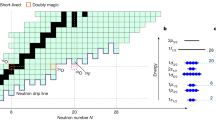Abstract
The complicated structure of the neutron cannot be calculated using first-principles calculations due to the large colour charge of quarks and the self-interaction of gluons. Its simplest structure observables are the electromagnetic form factors1, which probe our understanding of the strong interaction. Until now, a small amount of data has been available for the determination of the neutron structure from the time-like kinematical range. Here we present measurements of the Born cross section of electron–positron annihilation reactions into a neutron and anti-neutron pair, and determine the neutron’s effective form factor. The data were recorded with the BESIII experiment at centre-of-mass energies between 2.00 and 3.08 GeV using an integrated luminosity of 647.9 pb−1. Our results improve the statistics on the neutron form factor by more than a factor of 60 over previous measurements, demonstrating that the neutron form factor data from annihilation in the time-like regime is on par with that from electron scattering experiments. The effective form factor of the neutron shows a periodic behaviour, similar to earlier observations of the proton form factor. Future works—both theoretical and experimental—will help illuminate the origin of this oscillation of the electromagnetic structure observables of the nucleon.
This is a preview of subscription content, access via your institution
Access options
Access Nature and 54 other Nature Portfolio journals
Get Nature+, our best-value online-access subscription
$29.99 / 30 days
cancel any time
Subscribe to this journal
Receive 12 print issues and online access
$209.00 per year
only $17.42 per issue
Buy this article
- Purchase on Springer Link
- Instant access to full article PDF
Prices may be subject to local taxes which are calculated during checkout



Similar content being viewed by others
Data availability
Source data are provided with this paper. The raw data used for the plots within this paper and other findings of this study are archived in the Institute of High Energy Physics mass storage silo and are available from the corresponding author upon reasonable request.
Code availability
All algorithms used for data analysis and simulation are archived by the authors and are available on request.
References
Lomon, E. L. & Pacetti, S. Timelike and spacelike electromagnetic form factors of nucleons, a unified description. Phys. Rev. D 85, 113004 (2012); erratum 86, 039901 (2012).
Ashman, J. et al. A measurement of the spin asymmetry and determination of the structure function g1 in deep inelastic muon-proton scattering. Phys. Lett. B 206, 364–370 (1988).
Ji, X. D. A QCD analysis of the mass structure of the nucleon. Phys. Rev. Lett. 74, 1071–1074 (1995).
Bernauer, J. C. et al. High-precision determination of the electric and magnetic form factors of the proton. Phys. Rev. Lett. 105, 242001 (2010).
Pohl, R. et al. The size of the proton. Nature 466, 213–216 (2010).
Xiong, W. et al. A small proton charge radius from an electron–proton scattering experiment. Nature 575, 147–150 (2019).
Miller, G. A. Charge density of the neutron and proton. Phys. Rev. Lett. 99, 112001 (2007).
Shintani, E., Ishikawa, K. I., Kuramashi, Y., Sasaki, S. & Yamazaki, T. Nucleon form factors and root-mean-square radii on a (10.8 fm)4 lattice at the physical point. Phys. Rev. D 99, 014510 (2019); erratum 102, 019902 (2020).
Biagini, M. E., Cugusi, L. & Pasqualucci, E. U-spin considerations to guess the unknown time-like neutron form factors. Z. Phys. C 52, 631–634 (1991).
Antonelli, A. The first measurement of the neutron electromagnetic form factors in the timelike region. Nucl. Phys. B 517, 3–35 (1998).
Chernyak, V. L. & Zhitnitsky, A. R. Asymptotic behavior of exclusive processes in QCD. Phys. Rep. 112, 173–318 (1984).
Pacetti, S., Baldini, R. F. & Tomasi-Gustafsson, E. Proton electromagnetic form factors: basic notions, present achievements and future perspectives. Phys. Rep. 550–551, 1–103 (2015).
Lees, J. P. Study of e+e− → p\(\bar{p}\) via initial-state radiation at BABAR. Phys. Rev. D 87, 092005 (2013).
Arbuzov, A. B. & Kopylova, T. V. On relativization of the Sommerfeld-Gamow-Sakharov factor. J. High Energ. Phys. 2012, 9 (2012).
Ablikim, M. et al. Design and construction of the BESIII detector. Nucl. Instrum. Meth. A 614, 345–399 (2010).
Bernardini, C. et al. Lifetime and beam size in a storage ring. Phys. Rev. Lett. 10, 407–409 (1963).
Ping, R. G. An exclusive event generator for e+e− scan experiments. Chinese Phys. C 38, 083001 (2014).
Ablikim, M. et al. Luminosity measurements for the R scan experiment at BESIII. Chinese Phys. C 41, 063001 (2017).
Ablikim, M. et al. Measurement of integrated luminosity and center-of-mass energy of data taken by BESIII at \(\sqrt{s}\) = 2.125 GeV. Chinese Phys. C 41, 113001 (2017).
Ablikim, M. et al. Measurement of proton electromagnetic form factors in e+e− → p\(\bar{p}\) in the energy region 2.00–3.08 GeV. Phys. Rev. Lett. 124, 042001 (2020).
Ablikim, M. et al. Study of the process e+e− → p\(\bar{p}\) via initial state radiation at BESIII. Phys. Rev. D 99, 092002 (2019).
Bianconi, A. & Tomasi-Gustafsson, E. Periodic interference structures in the timelike proton form factor. Phys. Rev. Lett. 114, 232301 (2015).
Bianconi, A. & Tomasi-Gustafsson, E. Phenomenological analysis of near-threshold periodic modulations of the proton timelike form factor. Phys. Rev. C 93, 035201 (2016).
Lorenz, I. T., Hammer, F. W. & Meißner, U. G. New structures in the proton-antiproton system. Phys. Rev. D 92, 034018 (2015).
Thomas, A. W. Interplay of spin and orbital angular momentum in the proton. Phys. Rev. Lett. 101, 102003 (2008).
Pagels, H. Departures from chiral symmetry: a review. Phys. Rep. 16, 219–311 (1975).
Hand, L. N., Miller, D. G. & Wilson, R. Electric and magnetic form factors of the nucleon. Rev. Mod. Phys. 35, 335–349 (1963).
Hagen, G. et al. Neutron and weak-charge distributions of the 48Ca nucleus. Nat. Phys. 12, 186–190 (2015).
Andronic, A., Braun-Munzinger, P., Redlich, K. & Stachel, J. Decoding the phase structure of QCD via particle production at high energy. Nature 561, 321–330 (2018).
Adamczewski-Musch, J. et al. Probing dense baryon-rich matter with virtual photons. Nat. Phys. 15, 1040–1045 (2019).
Bauswein, A. Equation of state constraints from multi-messenger observations of neutron star mergers. Ann. Phys. 411, 167958 (2019).
Achasov, M. N. et al. Study of the process e+e– → n\(\bar{n}\) at the VEPP-2000 e+e− collider with the SND detector. Phys. Rev. D 90, 112007 (2014).
Druzhinin, V. P. & Serednyakov, S. I. Measurement of the e+e– → n\(\bar{n}\) cross section with the SND detector at the VEPP-2000 collider. EPJ Web Conf. 212, 07007 (2019).
Jegerlehner, F. Hadronic contributions to the photon vacuum polarization and their role in precision physics. J. Phys. G 29, 101–110 (2003).
Ping, R. G. et al. Tuning and validation of hadronic event generator for R value measurements in the tau-charm region. Chinese Phys. C 40, 113002 (2016).
Carloni Calame, C. M., Montagna, G., Nicrosini, O. & Piccinini, F. The BABAYAGA event generator. Nucl. Phys. B Proc. Sup. 131, 48–55 (2004).
Ping, R. G. et al. Event generators at BESIII. Chinese Phys. C 32, 599–602 (2008).
Ma, X. et al. Determination of event start time at BESIII. Chinese Phys. C 32, 744–749 (2008).
James, F. MINUIT—function minimization and error analysis: reference manual version 94.1. CERN-D506 (1994).
Fletcher, R. A new approach to variable metric algorithms. Comput. J. 13, 317–322 (1970).
Ablikim, M. et al. Study of J/Ψ → p\(\bar{p}\) and J/Ψ → n\(\bar{p}\). Phys. Rev. D 86, 032014 (2012).
Berger, N. et al. Trigger efficiencies at BESIII. Chinese Phys. C 34, 1779–1784 (2010).
Schmelling, M. Averaging correlated data. Phys. Scr. 51, 676–679 (1995).
Acknowledgements
We thank the staff of BEPCII, IHEP Computing Center and Supercomputing Center of USTC for their strong support. This work is supported in part by National Key R&D Program of China under contract nos. 2020YFA0406400 and 2020YFA0406300; National Natural Science Foundation of China (NSFC) under contract nos. 11625523, 11635010, 11735014, 11805124, 11822506, 11835012, 11935015, 11935016, 11935018, 11961141012, 12022510, 12025502, 12035009, 12035013, 12061131003, 11705192, 11950410506 and 12061131003; the Chinese Academy of Sciences (CAS) Large-Scale Scientific Facility Program; Joint Large-Scale Scientific Facility Funds of the NSFC and CAS under contract nos. U1732263, U1832207, U1832103 and U2032111; CAS Key Research Program of Frontier Sciences under contract no. QYZDJ-SSW-SLH040; 100 Talents Program of CAS; Guangdong Major Project of Basic and Applied Basic Research no. 2020B030103008; Science and Technology Program of Guangzhou (no. 2019050001); INPAC and Shanghai Key Laboratory for Particle Physics and Cosmology; ERC under contract no. 758462; European Union Horizon 2020 research and innovation programme under contract no. Marie Skłodowska-Curie grant agreement no. 894790; German Research Foundation DFG under contract no. 443159800; Collaborative Research Center CRC 1044, FOR 2359 and GRK 214; Istituto Nazionale di Fisica Nucleare, Italy; Ministry of Development of Turkey under contract no. DPT2006K-120470; National Science and Technology fund; Olle Engkvist Foundation under contract no. 200-0605; STFC (United Kingdom); The Knut and Alice Wallenberg Foundation (Sweden) under contract no. 2016.0157; The Royal Society, UK, under contract nos. DH140054 and DH160214; The Swedish Research Council; US Department of Energy under contract nos. DE-FG02-05ER41374 and DE-SC-0012069.
Author information
Authors and Affiliations
Consortia
Contributions
All the authors have contributed to this publication, being variously involved in the design and construction of the detectors, writing software, calibrating sub-systems, operating the detectors, acquiring data and analysing the processed data.
Ethics declarations
Competing interests
The authors declare no competing interests.
Additional information
Peer review information Nature Physics thanks Hyun-Chul Kim, Galina Pakhlova and Bogdan Wojtsekhowski for their contribution to the peer review of this work.
Publisher’s note Springer Nature remains neutral with regard to jurisdictional claims in published maps and institutional affiliations.
Supplementary information
Supplementary Information
Supplementary Figs. 1–8, discussion and Tables 1–5.
Source data
Source Data Fig. 2
Source data for Fig. 2.
Source Data Fig. 3
Source data for Fig. 3.
Rights and permissions
About this article
Cite this article
The BESIII Collaboration. Oscillating features in the electromagnetic structure of the neutron. Nat. Phys. 17, 1200–1204 (2021). https://doi.org/10.1038/s41567-021-01345-6
Received:
Accepted:
Published:
Issue Date:
DOI: https://doi.org/10.1038/s41567-021-01345-6
This article is cited by
-
An approach to study interactions of antineutrons with CsI at a \(J/\psi \) factory
Radiation Detection Technology and Methods (2024)
-
STCF conceptual design report (Volume 1): Physics & detector
Frontiers of Physics (2024)
-
News on the neutron structure
Nature Physics (2021)



